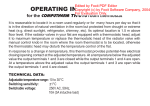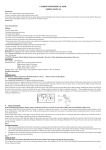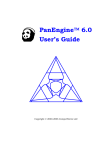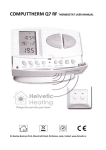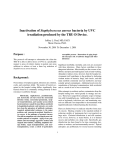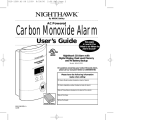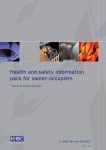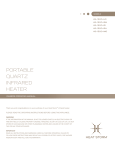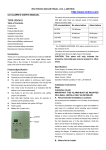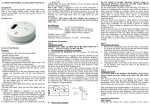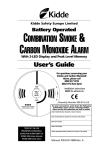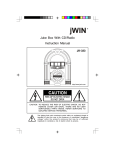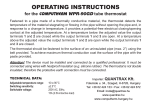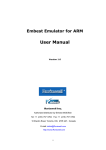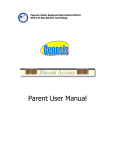Download COMPUTHERM
Transcript
COMPUTHERM CO1400 Carbon Monoxide Alarm OPERATING INSTRUCTIONS TABLE OF CONTENTS 1. INTRODUCTION 2. YOU SHOULD KNOW ABOUT CARBON MONOXIDE 3. SYMPTOMS OF CARBON MONOXIDE POISONING 4. LOCATIONS TO INSTALL YOUR ALARM 5. LOCATIONS NOT TO INSTALL YOUR ALARM 6. INSTALLING YOUR ALARM 7. TAKING CARE OF YOUR ALARM 8. OPERATION OF THE ALARM 9. ACTIONS TO TAKE WHEN ALARM SOUNDING 10. END OF LIFE ALARM 11. SPECIFICATIONS 12. SERVICE OR REPAIR INFORMATION 13. WARRANTY INFORMATION IMPORTANT WARNINGS STATEMENTS: Important! Read all instructions before installation and keep this user’s manual near the alarm for future reference. WARNING! Removal of the alarm battery will render the alarm inoperative. Our Carbon Monoxide Alarm requires a continuous supply of electrical power – it will not work without power. Carbon -1- monoxide alarms may wear out because they contain electronic parts that may fail at any time. Test your alarm at least every week (see the section „To Test”). If the Test Operation does not work, change the batteries, if the failure has not solved, please send for service. WARNING! This product is intended for use in ordinary indoor locations of family living units. It is not designed to measure compliance with Occupational Safety and Health Administration (OSHA) commercial or industrial standards. This alarm has not been investigated for carbon monoxide detection below 50 ppm. Individuals with medical problems may consider using warning devices which provide audible and visual signals for carbon monoxide concentrations under 30 ppm. CAUTION! This alarm will only indicate the presence of carbon monoxide at the sensor. Carbon monoxide may be present in other areas. CAUTION! Accommodation spaces are to be well ventilated when household cleaning supplies or similar contaminants are used. CAUTION! Installation of the apparatus should not be used as a substitute for proper installation, use and maintenance of fuel burning appliances including appropriate ventilation and exhaust systems. Important! This carbon monoxide alarm is designed to detect carbon monoxide gas from ANY source of combustion. It is NOT designed to detect smoke, fire or any other gas. -2- Warning! Modifying the socket can cause electric shock or product failure. CAUTION! The carbon monoxide alarm does not protect from chronic effects of carbon monoxide exposure and does not provide all-round safety for people who are especially imperiled. 1. INTRODUCTION Our Carbon Monoxide (CO) Alarm is designed to monitor the air for the presence of CO in your home or office. It will alarm independently when potentially dangerous levels exist. And it is a battery operated unit, powered by 3*AA batteries. The features of our COMPUTHERM CO1400 CO alarm include: • Easy to install. • Monitors for carbon monoxide in a continuous manner. • Loud alarm (85 dB) when it detects a buildup of carbon monoxide. • Test button for you to test the alarm anytime. • Self-testing its operative function continuously. • Complies with the requirements EN 502911:2010 • End of Sensor Life Indicator. • 5-year warranty for the carbon monoxide -3- alarm, and the end-of-life is based on the date manufactured. 2.YOU SHOULD KNOW ABOUT CARBON MONOXIDE Carbon Monoxide, also known as “CO” by the chemical name, is considered to be a highly dangerous poisonous gas, because it is colorless, odorless, tasteless and very toxic. In general, biochemistry phenomena have shown that the presence of CO gas inhibits the blood’s capacity to transport oxygen throughout the body, which can eventually lead to brain damage. In any enclosed space (home, office, recreational vehicle or boat) even a small accumulation of CO gas can be quite dangerous. Although many products of combustion can cause discomfort and adverse health effects, it is CO gas which presents the greatest threat to life. Carbon monoxide is produced by the incomplete combustion of fuels such as natural gas, propane, heating oil, kerosene, coal, charcoal, gasoline, or wood. The incomplete combustion of fuel can occur in any device which depends on burning for energy or heat such as furnaces, boilers, room heaters, hot water heaters, stoves, grills, and in any gasoline powered vehicle or engine (e.g. gen- -4- erator set, lawnmower). Tobacco smoke also adds CO to the air you breathe. When properly installed and maintained, your natural gas furnace and hot water heater do not pollute your air space with CO. Natural gas is known as a “clean burning” fuel because under correct operating conditions, the combustion products are water vapor and carbon dioxide (CO2), which is not toxic. The products of combustion are exhausted from furnaces and water heaters to the outside by means of a fuel duct or chimney. The following conditions can result in transient CO situations: 1.Excessive spillage or reverse venting of fuel burning appliances caused by outdoor ambient conditions such as wind direction and/or velocity, including high gusts of wind; heavy air in the vent pipes (cold/humid air with extended periods between cycles). 2.Negative pressure differential resulting from the use of exhaust fans. 3.Simultaneous operation of several fuel burning appliances competing for limited internal air. 4.Vent pipe connection vibrating loose from clothes dryers, furnaces, or water heaters. 5.Obstructions in or unconventional vent pipe -5- designs which amplify the above situations. 6.Extended operation of unvented fuel burning devices (range, oven, fireplace, etc.). 7. Temperature inversions which can trap exhaust gasses near the ground. 8.Car idling in an open or closed attached garage, or near a home. Correct operation of any burning equipment requires two key conditions: 1. An adequate supply of air for complete combustion. 2.Proper venting of the products of combustion from the furnace through the chimney, vent or duct to the outside. Typical carbon monoxide gas problems are summarized here: 1. Equipment problems, due to defects, poor maintenance, damaged and cracked heat exchangers. 2. Collapsed or blocked chimneys or flues, dislodged, disconnected or damaged vents. 3. Downdraft in chimneys or flues. This can be caused by very long or circuitous flue runs, improper location of flue exhaust or wind conditions. -6- 4. Improper installation or operation of equipment, chimney or vents. 5. Air tightness of house envelop/inadequate combustion of air. 6. Inadequate exhaust of space heaters or appliances. 7. Exhaust ventilation/fireplace competing for air supply. Potential sources of carbon monoxide in your home or office include clogged chimney, wood stove, wood or gas fireplace, automobile and garage, gas water heater, gas appliance, gas or kerosene heater, gas or oil furnace, and cigarette smoke. 3. SYMPTOMS OF CARBON MONOXIDE POISONING The following symptoms are related to CO poisoning and should be discussed with all members of the household so that you know what to look for: a. Mild Exposure: Slight headache, nausea, vomiting, fatigue (often described as “Flu-like” symptoms). b. Medium Exposure: Severe throbbing headache, drowsiness, confusion, vomiting, fast heart rate. c. Extreme Exposure: Unconsciousness, convulsions, cardio respiratory failure, death. -7- d. Many cases of reported CARBON MONOXIDE POISONING indicate that while victims are aware they are not well, they become so disoriented they are unable to save themselves by either exiting the building or calling for assistance, Young children and household pets are typically the first affected. e. Exposure during sleep is particularly dangerous because the victim usually does not awaken. CAUTION! The carbon monoxide alarm does not protect from chronic effects of carbon monoxide exposure and does not provide all-round safety for people who are especially imperiled. 4. LOCATIONS TO INSTALL YOUR ALARM Since CO gas moves freely in the air, the suggested location is in or as near as possible to sleeping areas of the home. The human body is most vulnerable to the effects of CO gas during sleeping hours. For maximum protection, a CO alarm should be located in or near bedrooms and living areas. It is recommended that you install a CO alarm on each level of a multi-level home. You may use the number and location of smoke alarms installed in your home according to current building code requirements as a guide to the loca- -8- tion of your CO alarm(s). In the figure below, are suggested locations in the home. When choosing your installation locations, make sure you can hear the alarm from all sleeping areas. if you install only one carbon monoxide alarm in your home, install the alarm near bedrooms, not in the basement or furnace room. IMPORTANT: This device is not suitable for installation in a hazardous location. 5. LOCATIONS NOT TO INSTALL YOUR ALARM BEDROOM BATH BEDROOM FAMILY/GREAT ROOM KITCHEN LIVING ROOM SPLIT LEVEL UTILITY ROOM BASEMENT CARBON MONOXIDE DETECTOR -9- BATH IMPORTANT: Improper location can affect the sensitive electronic components in this CO alarm. Do not place the alarm in the following areas: 1.Do not install this CO alarm in garages, kitchens or furnace rooms. Installation in these areas could lead to nuisance alarms, may expose the sensor to substances that could damage or contaminate it, or the alarm may not be heard by persons. In the kitchen and furnace room, some gas appliances can emit a short burst of carbon monoxide upon start-up. This is normal. If your CO alarm is mounted too close to these appliances, it may alarm often and become a nuisance. 2.In the garage, vehicle exhaust can contain some carbon monoxide. These levels are higher when the engine is first started. Within hours of starting a vehicle and backing it out of the garage, the levels present over time can activate the alarm and become a nuisance. 3.If you must install a CO alarm near a cooking or heating appliance, do not install within 1.5 meters of the appliance. 4. Do not install in where the temperature may drop below 4.4°C or exceed 37.8°C. 5. Dust grease or household chemicals can con- -10- taminate or coat the alarm’s sensor, causing the alarm not to operate properly. 6. Do not obstruct the vents. 7.Do not install in dead air space, such as peaks of vaulted ceilings or gabled roofs, where carbon monoxide may not reach the sensor in time to provide early warning. Do not install in exhaust streams from gas engines, vents, flues or chimneys. 8. Do not install near doors and windows that open to the outside, near fresh air vents, or anywhere that is drafty. Do not install near paint thinner fumes. 9.Do not install near deep cell large batteries. Large batteries have emissions that can cause the alarm to perform at less than optimum performance. Consequential or incidental damages for breach of this or other warranty, expressed or implied whatsoever, even if the loss or damage is caused by the Company’s negligence or fault. 6. INSTALLING YOUR ALARM THE APPARATUS SHOULD BE INSTALLED BY A COMPETENT PERSON! Your Carbon Monoxide Alarm is easy to install to protect you and your family in your home, cottage, cabin and office. -11- The alarm can either be used as a free-standing unit or can be wall mounted using the fixings provided. Wall mounting installation: 1. Installing your batteries: Batteries were not installed at the factory and must be installed for the unit to operate. And please Install three AA alkaline batteries in the back of the CO alarm. Open battery door by lifting up on the lip at the bottom edge of the alarm. The battery polarity markings on the bottom of the battery compartment must be adhered to. Batteries must be installed in the sequence shown following. If batteries seem difficult to install, they’re being installed in the improper sequence. After the batteries are correctly installed the unit will beep once, the green LED will flash once every second for 45 seconds indicating warming up, after warming up, the green LED flashes once every 45 seconds to indicate the unit is operated normally. If any form of battery failure is detected the yellow LED will flash once and sound a short beep every 45 seconds, and will continue for at least seven days, it means the batteries -12- should be replaced. Replace batteries with alkaline batteries. NOTE: Battery polarities must be correctly installed. Otherwise, damage might be caused to the alarm. NOTE: Constant exposures to high or low humidity may reduce battery life. WARNING: Use only the batteries specified. Use of different batteries may have a detrimental effect on the CO alarm. 2. At the place where you are going to install the alarm, draw a horizontal line 9cm long. 3. Using a 5mm drill bit, drill two holes at the end of the line and insert wall plugs. 4. Using the two screws and wall plugs (all supplied), don’t screw too firmly into the wall. 5. Hung the alarm on the protruding fixing pin using the ‘keyholes’ on the back. -13- 7. TAKING CARE OF YOUR ALARM You have to maintain the alarm frequently to ensure it remains working properly. A few tips are provided for you to take care of your alarm. What you should do: 1. Test the alarm weekly by pressing the TEST/ HUSH button. -14- 2. Vacuum the alarm cover once a month to remove accumulated dust. Use the soft brush attachment of your vacuum cleaner. 3. Instruct children never to touch, or otherwise interfere with the alarm. Warn children of the dangers of CO poisoning. What you should not do: 1. Never use detergents or solvents to clean the alarm. Chemicals can permanently damage or temporarily contaminate the sensor. 2. Avoid spraying air fresheners, hair spray, paint or other aerosols near the alarm. 3. Do not paint the alarm. Paint will seal the vents and interfere with proper sensor operation. NOTE: If you will be staining or stripping wood floors or furniture, painting, wall-papering, or using aerosols or adhesives for a DIY project or hobby, before you begin: Remove the alarm to a remote location to prevent possible damage to or contamination of the sensor. You may wish to remove the alarm and store in a plastic bag during the project. The following is a list of substances that at high levels can affect the sensor: Methane, propane, iso-butane, ethylene, ethanol, alcohol, iso-propanol, benzene, toluene, ethyl acetate, hydrogen, hydrogen sulfide, sulfur dioxides. -15- Also most aerosol sprays, alcohol based products, paints, thinners, solvents, adhesives, hair sprays, aftershaves, perfumes, auto exhaust (cold start) and some cleaning agents. 8. OPERATION OF THE ALARM a. Warm-Up: when the battery is installed to the unit, it will give a short beep within 5 seconds to indicate the unit is receiving power. Then the green LED light will flash once every second for 45 seconds to indicate the unit is warming up. b. Normal Operation: If the unit is in the normal operation, the green LED light will flash once about every 45 seconds, with no beeps. c. Test: The green LED light flashing once every 45 seconds without beeps shows that the unit is in normal operation. To test the alarm (do not test when alarm is warming up.), press the TEST/HUSH button, the all LED lights flash, and the unit gives four short beeps every 5 second. Such as the sequence that 4 short beeps, followed by 5 seconds of silence, then followed by 4 short beeps. That will repeat at least 2 times, after released the TEST/HUSH button. If the Test Operating DOES NOT work, please replace with a new one, and send for service. -16- d. Alarm status: When the unit detects a dangerous level of CO gas, it will give the alarm signal continuously. The red LED light will flash and the unit will give 4 short beeps every 5 seconds. The alarm pattern is 4 short beeps – followed by 5 seconds of silence – followed by 4 short beeps, repeat. And the alarm pattern will continue for the first 4 minutes after detecting CO and then the cycle will repeat every one minute. e. Hush: If the alarm is sounding, you can press the TEST/HUSH button to quickly silence the alarm. Then it will be silent, and will be reenergized about 5 minutes from the time the button is pressed if the concentration of carbon monoxide surrounding the alarm remains at 50 ppm or greater. f. Hush Status: if required, you can press the TEST/HUSH button to quickly silence unwanted alarm. Then the unit will be silent, and will be reenergized about 5 minutes from the time the button is pressed if the concentration of carbon monoxide surrounding the alarm remains at 70 ppm or greater. g. Low battery status: When the battery is low and needs replacing, the yellow LED light will flash once about every 45 seconds, and the unit will give a short beep simultaneously every 45 seconds. The battery must be replaced. -17- NOTE: For replacement battery, use 3x1,5V alkaline batteries. h. Fault status: When the unit tests any fault of itself, such as sensor fault, the yellow LED light will flash twice every 45 seconds, and the unit will give a short beep simultaneously every 45 seconds. If this occurs, DO NOT rely on this alarm. The unit needs to be serviced or replaced. Send the malfunctioning unit to the manufacturer for service. i. End of Life: The unit provides 5 years of continuous operation. It will automatically alert you to replace. The end-of-life is based on the date the unit was manufactured. When the unit comes to the end of its life, the yellow LED light will flash twice every 45 seconds, and the unit will give 2 short beeps simultaneously every 45 seconds. The unit must be replaced. NOTE: If the unit does not alarm, press the TEST/ HUSH button to test. If the unit alarms, press the TEST/HUSH button to silence the alarm. NOTE: The alarm automatically resets when CO is no longer detected. NOTE: When the alarm is warming up, Do not press the TEST/HUSH button. -18- 9. ACTIONS TO TAKE WHEN ALARM SOUNDING In case of harmful levels of CO gas being detected, your alarm will go into a continuous full alarm. Take the following necessary actions immediately: 1. If there is anyone experiencing the effects of carbon monoxide poisoning such as headache, dizziness, nausea or other flu-like symptoms, call your fire department right away or your emegency sercives phone number. You should evacuate all the people in the premises immediately. Do a head count to check that everybody is accounted for. 2. Do not re-enter the premises until the problem has been corrected and the CO gas has been dispersed out and a safe level is reached. 3. If no symptoms exist, immediately, ventilate the home by opening windows and doors. Turn off fuel burning appliances and call a qualified technician or your utility company to inspect and repair your problem before restarting appliances. WARNING: Actuation of your CO alarm indicates the presence of carbon monoxide (CO) which can KILL YOU. If alarm signal sounds: 1. Operate TEST/HUSH button. -19- 2. Call your emergency services phone number. 3. Immediately move to fresh air – outdoors or by an open door/window. Do a head count to check that all persons are accounted for. Do not reenter the premises nor move away from the open door/ window until the emergency services responders have arrived, the premises have been aired out, and your alarm remains in its normal condition. 4. After following steps 1–3, if your alarm reactivates within a 24 hour period, repeat steps 1–3 and call a qualified appliance technician to investigate for sources of CO from fuel burning equipment and appliances, and inspect for proper operation of this equipment. If problems are identified during this inspection have the equipment serviced immediately. Note any combustion equipment not inspected by the technician and consult the manufacturers’ instructions, or contact the manufacturers directly, for more information about CO safety and this equipment. Make sure that motor vehicles are not, and have not been, operating in an attached garage or adjacent to the residence. CAUTION: This alarm will only indicate the presence of CO gas at the sensor. CO gas maybe present in other areas in the premises. -20- 10. END OF LIFE ALARM During operation, the alarm carries out a selfcheck every minute. The alarm will operate 5 years under normal use. The end-of-life is based on the date the unit was manufactured included in the serial number. The alarm must be replaced when either the End of Life Alarm Signal is given (yellow LED light flash twice every 45 seconds and buzzer sounds 2 short beeps every 45 seconds) or the test button does not work. 11. SPECIFICATIONS Gas Detected: CO sensor type: Carbon monoxide Nemoto (Japanese) electrochemical sensor Detection Principle: Electro-chemical cell Power Supply: 3 x 1,5V alkaline batteries Audible Alarm: 85dB minimum at 3 meter Operating Temperature: 4°C to 37°C Storage temperature: 0.0°C to 40.0°C Humidity Range: 15 to 90 (%RH ) Life expectancy: 5 years Dimensions: 112 x 64 x 36 mm Weight: 109g Carbon monoxide response times: -21- The COMPUTHERM CO1400 Carbon Monoxide alarm meets requirements of EN 50291-1:2014 as follows: 50 ppm EN Standard alarm within 60-90 minutes 100 ppm alarm within 10-40 minutes 300 ppm alarm within 3 minutes 12.SERIVICE OR REPAIR INFORMATION For service or repair, return your Carbon Monoxide Alarm intact, stating the reason for return and details of any fault, to the distributor who supplied the product. 13. WARRANTY INFORMATION Limited Warranty: We warrant our enclosed Carbon Monoxide Alarm sensor to be free from defects in material and workmanship under normal use and service for a period of five (5) years from date of production. We make no other express warranty for this Carbon Monoxide Alarm. No agent, representative, dealer or employee of the Company has the authority to increase or alter the obligation of this warranty. The Company shall not be obligated to repair or replace units which are found to be in need of re- -22- pair because of damage, unreasonable use, modifications, or alterations occurring after the date of purchase. In no case shall the Company be liable for any consequential or incidental damages for breach of this or other warranty, expressed or implied whatsoever, even if the loss or damage is caused by the Company’s negligence or fault. The COMPUTHERM CO1400 type carbon monoxide alarm complies with the requirements of standards EU EMC 2004/108/EC and RoHS 2011/65/EU. Importer: Thermostats4U Email: [email protected] For additional information visit: thermostats4U.co.uk For better reading download this Operating Instruction from our website! Origin: Made in China
























